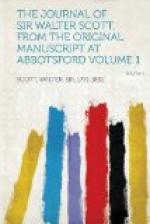[401] A Sunday newspaper started in 1820, to advocate the cause of George IV., and to vilify the Queen and her friends, male and female. The first number was published on December 17th, and “told at once from the convulsed centre to the extremity of the Kingdom. There was talent of every sort in the paper that could have been desired or devised for such a purpose. It seemed as if a legion of sarcastic devils had brooded in Synod over the elements of withering derision.” Hook, however, was the master spirit, the majority of the lampoons in prose, and all the original poetry in the early volumes from the “Hunting the Hare,” were from his own pen, except, perhaps, “Michael’s Dinner,” which has been laid at Canning’s door.
Oddly enough Scott appears to have been the indirect means of placing Hook in the editorial chair. When he was in London, in April 1820, a nobleman called upon him, and asked if he could find him in Edinburgh some clever fellow to undertake the editorship of a paper about to be established. Sir Walter suggested that his Lordship need not go so far a-field, described Hook’s situation, and the impression he had received of him from his table talk, and his Magazine, the Arcadian. This was all that occurred, but when, towards the end of the year, John Bull electrified London, Sir Walter confessed that he could not help fancying that his mentioning this man’s name had had its consequences.
Hook, in spite of his L2000 per annum for several years from John Bull, and large prices received for his novels, died in poverty in 1841, a prematurely aged man. His sad story may be read in a most powerful sketch in the Quarterly Review, attributed to Mr. Lockhart.
[402] See Beckford’s Vathek, Hall of Eblis.
[403] Lady Stafford says: “We were so lucky as to have Sir W. Scott here for a day, and were glad to see him look well, and though perfectly unaltered by his successes, yet enjoying the satisfaction they must have given him.”—Sharpe’s Letters, vol. ii. p. 379.
[404] The Right Hon. Thomas Grenville died in 1846 at the age of ninety-one. He left his noble collection of books to the nation.
[405] The Right Hon. Charles Manners Sutton, afterwards Viscount Canterbury. He died in 1845.
[406] Mrs. Arbuthnot was Harriet, third daughter of the Hon. H. Fane, and wife of Charles Arbuthnot, a great friend of the Duke of Wellington. She died in 1838, Mr. Arbuthnot in 1850.
[407] Sir Walter had recommended George Cranstoun, his early friend, one of the brethren of the mountain, who succeeded Lord Hermand, and took his seat on the Scotch bench before the end of the month. The appointment satisfied both political parties, though Cockburn said that “his removal was a great loss to the bar which he had long adorned, and where he had the entire confidence of the public.” An admirable sketch of Cranstoun is given in No. 32 of Peter’s Letters. He retired in 1839, and died at Corehouse, his picturesque seat on the Clyde, in 1850.




